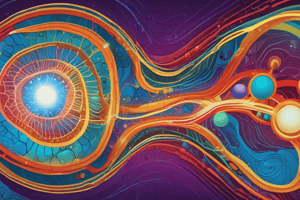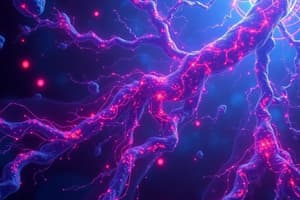Podcast
Questions and Answers
What are the two compartments formed by the double-membrane mitochondrion?
What are the two compartments formed by the double-membrane mitochondrion?
Which of the following stages of aerobic respiration occurs first?
Which of the following stages of aerobic respiration occurs first?
What is the main product of glycolysis?
What is the main product of glycolysis?
Which phrase describes the Energy Investment Phase of glycolysis?
Which phrase describes the Energy Investment Phase of glycolysis?
Signup and view all the answers
What happens to pyruvate during the formation of acetyl-CoA?
What happens to pyruvate during the formation of acetyl-CoA?
Signup and view all the answers
In aerobic respiration, what is produced as a direct result of glucose oxidation?
In aerobic respiration, what is produced as a direct result of glucose oxidation?
Signup and view all the answers
Which of the following correctly describes the role of NAD+ in glycolysis?
Which of the following correctly describes the role of NAD+ in glycolysis?
Signup and view all the answers
Where does glycolysis occur within a cell?
Where does glycolysis occur within a cell?
Signup and view all the answers
What is produced when a coenzyme-A is attached to pyruvate?
What is produced when a coenzyme-A is attached to pyruvate?
Signup and view all the answers
How many NADH molecules are produced during one cycle of the Krebs cycle per glucose molecule?
How many NADH molecules are produced during one cycle of the Krebs cycle per glucose molecule?
Signup and view all the answers
Which molecule is regenerated at the end of the Krebs cycle?
Which molecule is regenerated at the end of the Krebs cycle?
Signup and view all the answers
What type of reactions do the electron transport chain involve?
What type of reactions do the electron transport chain involve?
Signup and view all the answers
Which component carries high-energy electrons to the electron transport chain?
Which component carries high-energy electrons to the electron transport chain?
Signup and view all the answers
Who received the Nobel Prize for the identification of the Krebs cycle?
Who received the Nobel Prize for the identification of the Krebs cycle?
Signup and view all the answers
In which part of the cell does the Krebs cycle occur?
In which part of the cell does the Krebs cycle occur?
Signup and view all the answers
What is formed when a four-carbon molecule oxaloacetate accepts a two-carbon acetyl group?
What is formed when a four-carbon molecule oxaloacetate accepts a two-carbon acetyl group?
Signup and view all the answers
What is the total maximum ATP yield from one glucose molecule during aerobic respiration?
What is the total maximum ATP yield from one glucose molecule during aerobic respiration?
Signup and view all the answers
How much ATP does the oxidation of FADH2 yield per molecule?
How much ATP does the oxidation of FADH2 yield per molecule?
Signup and view all the answers
Which process occurs in the absence of oxygen to generate ATP?
Which process occurs in the absence of oxygen to generate ATP?
Signup and view all the answers
What is the primary function of NADH produced during glycolysis?
What is the primary function of NADH produced during glycolysis?
Signup and view all the answers
What is the yield of ATP from the two NADH molecules produced in glycolysis in eukaryotes?
What is the yield of ATP from the two NADH molecules produced in glycolysis in eukaryotes?
Signup and view all the answers
Which organic molecule can enter glycolysis after being converted to pyruvate?
Which organic molecule can enter glycolysis after being converted to pyruvate?
Signup and view all the answers
What is the caloric value of one gram of lipid in the diet?
What is the caloric value of one gram of lipid in the diet?
Signup and view all the answers
Which of the following statements about the Krebs cycle is accurate?
Which of the following statements about the Krebs cycle is accurate?
Signup and view all the answers
Which enzyme complex is responsible for reducing NADH?
Which enzyme complex is responsible for reducing NADH?
Signup and view all the answers
Which of the following electron carriers can exist in both oxidized and reduced forms?
Which of the following electron carriers can exist in both oxidized and reduced forms?
Signup and view all the answers
What is the primary function of flavin mononucleotide (FMN) in the electron transport chain?
What is the primary function of flavin mononucleotide (FMN) in the electron transport chain?
Signup and view all the answers
Which complex is located after the cytochrome b/c1 reductase complex in the electron transport chain?
Which complex is located after the cytochrome b/c1 reductase complex in the electron transport chain?
Signup and view all the answers
What process is represented by the equation 2 H+ + 1/2 O2 → H2O?
What process is represented by the equation 2 H+ + 1/2 O2 → H2O?
Signup and view all the answers
Which of the following complexes directly contributes to the generation of a proton gradient?
Which of the following complexes directly contributes to the generation of a proton gradient?
Signup and view all the answers
Which of the following statements about the electron transport chain is false?
Which of the following statements about the electron transport chain is false?
Signup and view all the answers
What is the end product when electrons are finally transferred to oxygen in the electron transport chain?
What is the end product when electrons are finally transferred to oxygen in the electron transport chain?
Signup and view all the answers
What is the primary purpose of cellular respiration in cells?
What is the primary purpose of cellular respiration in cells?
Signup and view all the answers
Which type of organism can switch from aerobic respiration to fermentation when oxygen is unavailable?
Which type of organism can switch from aerobic respiration to fermentation when oxygen is unavailable?
Signup and view all the answers
In cellular respiration, what is the role of the final electron acceptor when it is oxygen?
In cellular respiration, what is the role of the final electron acceptor when it is oxygen?
Signup and view all the answers
What is the chemical equation for the process of cellular respiration using glucose as fuel?
What is the chemical equation for the process of cellular respiration using glucose as fuel?
Signup and view all the answers
What is the primary role of NADH and FADH2 in the electron transport chain?
What is the primary role of NADH and FADH2 in the electron transport chain?
Signup and view all the answers
What is often referred to as the 'power station' of the cell?
What is often referred to as the 'power station' of the cell?
Signup and view all the answers
Which process couples electron transport to ATP synthesis?
Which process couples electron transport to ATP synthesis?
Signup and view all the answers
What is the final electron acceptor in the electron transport chain?
What is the final electron acceptor in the electron transport chain?
Signup and view all the answers
What is produced alongside ATP during cellular respiration?
What is produced alongside ATP during cellular respiration?
Signup and view all the answers
Which of the following processes occurs in the mitochondria?
Which of the following processes occurs in the mitochondria?
Signup and view all the answers
What is formed as electrons from NADH or FADH2 lose energy while moving through the electron transport chain?
What is formed as electrons from NADH or FADH2 lose energy while moving through the electron transport chain?
Signup and view all the answers
What type of respiration occurs when there is no oxygen available?
What type of respiration occurs when there is no oxygen available?
Signup and view all the answers
How does the proton gradient contribute to ATP synthesis?
How does the proton gradient contribute to ATP synthesis?
Signup and view all the answers
What type of process is the diffusion of protons through ATP synthase?
What type of process is the diffusion of protons through ATP synthase?
Signup and view all the answers
In which part of the cell does oxidative phosphorylation primarily occur?
In which part of the cell does oxidative phosphorylation primarily occur?
Signup and view all the answers
What is the role of ATP synthase in the process of ATP production?
What is the role of ATP synthase in the process of ATP production?
Signup and view all the answers
Flashcards
Bioenergetics
Bioenergetics
The study of how organisms manage their energy resources.
Cellular Respiration
Cellular Respiration
Process where cells break down glucose to generate ATP, the cell's energy currency.
Photosynthesis
Photosynthesis
Process where plants use sunlight to convert carbon dioxide and water into sugar and oxygen.
Aerobic
Aerobic
Signup and view all the flashcards
Anaerobic
Anaerobic
Signup and view all the flashcards
Facultative Anaerobe
Facultative Anaerobe
Signup and view all the flashcards
Mitochondrion
Mitochondrion
Signup and view all the flashcards
ATP
ATP
Signup and view all the flashcards
Electron Transport Chain
Electron Transport Chain
Signup and view all the flashcards
Electron Carriers
Electron Carriers
Signup and view all the flashcards
Oxidized and Reduced Forms
Oxidized and Reduced Forms
Signup and view all the flashcards
Redox Reactions
Redox Reactions
Signup and view all the flashcards
Complex I
Complex I
Signup and view all the flashcards
Complex II
Complex II
Signup and view all the flashcards
Complex III
Complex III
Signup and view all the flashcards
Complex IV
Complex IV
Signup and view all the flashcards
Pyruvate Dehydrogenase
Pyruvate Dehydrogenase
Signup and view all the flashcards
Acetyl-CoA
Acetyl-CoA
Signup and view all the flashcards
Krebs Cycle
Krebs Cycle
Signup and view all the flashcards
Citric Acid Cycle
Citric Acid Cycle
Signup and view all the flashcards
Oxaloacetate
Oxaloacetate
Signup and view all the flashcards
Mitochondrial Membrane
Mitochondrial Membrane
Signup and view all the flashcards
Proton Gradient
Proton Gradient
Signup and view all the flashcards
Chemiosmosis
Chemiosmosis
Signup and view all the flashcards
ATP Synthase
ATP Synthase
Signup and view all the flashcards
Oxidative Phosphorylation
Oxidative Phosphorylation
Signup and view all the flashcards
Energy Loss
Energy Loss
Signup and view all the flashcards
Final Electron Acceptor
Final Electron Acceptor
Signup and view all the flashcards
Role of NADH and FADH2
Role of NADH and FADH2
Signup and view all the flashcards
Mitochondrial Compartments
Mitochondrial Compartments
Signup and view all the flashcards
Aerobic Respiration Equation
Aerobic Respiration Equation
Signup and view all the flashcards
Stages of Aerobic Respiration
Stages of Aerobic Respiration
Signup and view all the flashcards
Glycolysis: What happens?
Glycolysis: What happens?
Signup and view all the flashcards
Glycolysis Phases
Glycolysis Phases
Signup and view all the flashcards
Glycolysis: Outputs
Glycolysis: Outputs
Signup and view all the flashcards
Formation of Acetyl-CoA: What happens?
Formation of Acetyl-CoA: What happens?
Signup and view all the flashcards
Formation of Acetyl-CoA: Where?
Formation of Acetyl-CoA: Where?
Signup and view all the flashcards
ATP Yield from Glucose
ATP Yield from Glucose
Signup and view all the flashcards
NADH and FADH2
NADH and FADH2
Signup and view all the flashcards
Fermentation
Fermentation
Signup and view all the flashcards
Other Fuels for Respiration
Other Fuels for Respiration
Signup and view all the flashcards
Glycolysis
Glycolysis
Signup and view all the flashcards
Study Notes
Bioenergetics Overview
- Covers energy, cellular respiration, and photosynthesis
- Relates energy transfer within ecosystems
Cellular Respiration
- Aerobic respiration: Requires oxygen; produces ATP from glucose.
- Anaerobic respiration: Does not require oxygen; uses an inorganic molecule as the final electron acceptor instead.
- Fermentation: Uses an organic molecule as the final electron acceptor to regenerate NAD+ for glycolysis.
Mitochondrion Structure and Function
- Double-membrane structure with compartments:
- Outer membrane
- Inner membrane
- Intermembrane space
- Matrix
- Cristae (folds in inner membrane)
Aerobic Respiration (Redox Process)
- Consists of four main stages:
- Glycolysis
- Formation of Acetyl-CoA
- Krebs cycle
- Electron transport chain/Chemiosmosis
- The overall reaction pathway for glucose is: C₆H₁₂O₆ + 6O₂ → 6CO₂ + 6H₂O + Energy
- Oxidation and reduction occur during the process
Glycolysis
- Breakdown of glucose into pyruvate (in the cytosol)
- Two phases:
- Energy investment phase (requires ATP)
- Energy liberation phase (produces ATP and NADH)
- Net gain of 2 ATP, 2 NADH, and 2 Pyruvate
Formation of Acetyl-CoA
- Occurs in the mitochondria
- Pyruvate is converted to Acetyl-CoA
- Generates NADH and releases CO₂
Krebs Cycle (Tricarboxylic Acid Cycle)
- Takes place in the mitochondrial matrix
- Acetyl-CoA enters the cycle and combines with oxalacetate to form citrate.
- Series of eight reactions that complete the breakdown of glucose to CO2.
- Produces 2 ATP, 6 NADH, and 2 FADH2 per glucose molecule
Electron Transport Chain
- Complex series of electron carriers embedded in the inner mitochondrial membrane.
- Electrons from NADH and FADH2 are passed along the chain releasing energy.
- The energy is used to pump H+ ions into the intermembrane space.
- This creates a gradient that drives ATP synthesis.
Chemiosmosis
- Process of ATP synthesis fueled by the H+ gradient.
- H+ ions diffuse back into the matrix through ATP synthase.
- This drives the production of ATP from ADP.
Oxidative Phosphorylation
- Coupled to the electron transport chain.
- Most ATP synthesis occurs in this process.
- ATP synthase is the enzyme responsible for ATP production
Summary of Aerobic Respiration ATP Production
- Glycolysis: 2 ATP
- Pyruvate grooming: 2 NADH
- Krebs cycle: 2 ATP + 6 NADH + 2 FADH₂
- Total ATP per glucose molecule (~36-38 ATP) *Depending on the shuttle system
Fermentation
- Alternative energy production in the absence of oxygen.
- Two common types:
- Alcoholic fermentation
- Lactic acid fermentation
- Regenerates NAD+ to allow glycolysis to continue, enabling a low yield of ATP production through substrate-level phosphorylation.
Other Organic Molecules as Fuels
- Carbohydrates (glucose), proteins (amino acids), and fats (glycerol and fatty acids) can all be used as fuels for cellular respiration.
- Each molecule has different entry points.
- Different fuels will yield different amounts of ATP.
Studying That Suits You
Use AI to generate personalized quizzes and flashcards to suit your learning preferences.
Related Documents
Description
This quiz covers essential concepts in bioenergetics, focusing on energy transfer in cellular respiration and photosynthesis. Key topics include the structure and function of mitochondria, types of respiration, and the stages of aerobic respiration. Test your understanding of these critical biological processes!




